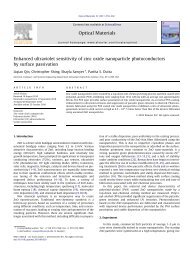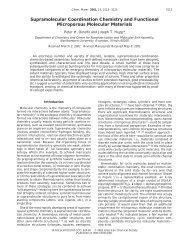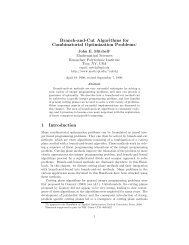Systematic development of coarse-grained polymer models Patrick ...
Systematic development of coarse-grained polymer models Patrick ...
Systematic development of coarse-grained polymer models Patrick ...
Create successful ePaper yourself
Turn your PDF publications into a flip-book with our unique Google optimized e-Paper software.
3.10 Comparison <strong>of</strong> the fractional extension with its high ν asymptotic expansion for the<br />
MarkoandSiggiapotential................................. 37<br />
3.11 Comparison <strong>of</strong> the zero-force slope with its high ν asymptotic expansion for the<br />
MarkoandSiggiapotential................................. 39<br />
3.12 Calculation <strong>of</strong> the relative error <strong>of</strong> the mean fractional extension for a bead-spring<br />
model as the level <strong>of</strong> <strong>coarse</strong>-graining changes with the FENE potential. . . . . . . . 43<br />
3.13 Calculation <strong>of</strong> λ for the three different criteria at different levels <strong>of</strong> <strong>coarse</strong>-graining<br />
fortheFENEpotential. .................................. 44<br />
3.14 Calculation <strong>of</strong> the relative error <strong>of</strong> the mean fractional extension for a bead-spring<br />
model for different best fit criteria with the FENE potential. . . . . . . . . . . . . . 45<br />
3.15 Calculation <strong>of</strong> the longitudinal root-mean-squared fluctuations at different levels <strong>of</strong><br />
<strong>coarse</strong>-grainingwiththeFENEpotential. ........................ 46<br />
3.16 Calculation <strong>of</strong> the transverse root-mean-squared fluctuations at different levels <strong>of</strong><br />
<strong>coarse</strong>-grainingwiththeFENEpotential. ........................ 47<br />
4.1 Multiplepathstobuildabead-springmodel. ...................... 52<br />
4.2 Physical interpretation <strong>of</strong> Polymer Ensemble Transformation (PET) method. . . . . 53<br />
4.3 The physical justification for the PET method is based on sorting all configurations<br />
<strong>of</strong>the<strong>polymer</strong>intocategories. .............................. 54<br />
4.4 Comparison <strong>of</strong> the spring force law chosen from the Random Walk Spring (RWS)<br />
model and the inverse Langevin function. . ....................... 57<br />
4.5 Progression from the constant extension partition function to the spring force in the<br />
Random Walk Spring model for ν =3........................... 58<br />
4.6 Series <strong>of</strong> spring forces necessary to model chains with m rods <strong>of</strong> length A and m rods<br />
<strong>of</strong> length 5A for m =1, 2, 3, 4, 5, 6, with the arrow denoting increasing m. . . . . . . 61<br />
4.7 Series <strong>of</strong> spring forces necessary to model chains with m rods <strong>of</strong> length A and m rods<br />
<strong>of</strong> length pA for m =1, 2, 3, 4, 5, 6, with the arrow denoting increasing m. . . . . . . 62<br />
4.8 This shows the convergence <strong>of</strong> a BD simulation for a spring force law that <strong>models</strong><br />
two rods <strong>of</strong> a freely jointed chain. . . ........................... 63<br />
4.9 This shows the convergence <strong>of</strong> a BD simulation for a spring force law that <strong>models</strong><br />
three rods <strong>of</strong> a freely jointed chain. . ........................... 64<br />
4.10 Relative error in the equilibrium moments <strong>of</strong> the spring length between an approximate<br />
spring force law compared with an equal rod freely jointed chain. . . . . . . . . 68<br />
4.11 Relative error in the average fractional extension between an approximate spring<br />
force law compared with an equal rod freely jointed chain. ............... 69<br />
4.12 Relative error in the equilibrium moments <strong>of</strong> the spring length between an approximate<br />
spring force law compared with a unequal rod freely jointed chain. . . . . . . . 70<br />
4.13Springforcelawforadumbbellmodel<strong>of</strong>F-actin..................... 71<br />
4.14 Restricting the configurations within a category eliminates the coupling in a multispringworm-likechainmodel................................<br />
72<br />
4.15 Illustration <strong>of</strong> a worm-like chain with vectors connecting positions on the chain. . . . 74<br />
4.16 Sketch <strong>of</strong> the average fractional extension as a function <strong>of</strong> the applied force for a<br />
continuousworm-likechainmodel. ............................ 75<br />
4.17 Relative error in the fractional extension versus force for the Marko-Siggia spring<br />
usingthelow-forcecriterionfortheeffectivepersistencelength............. 78







